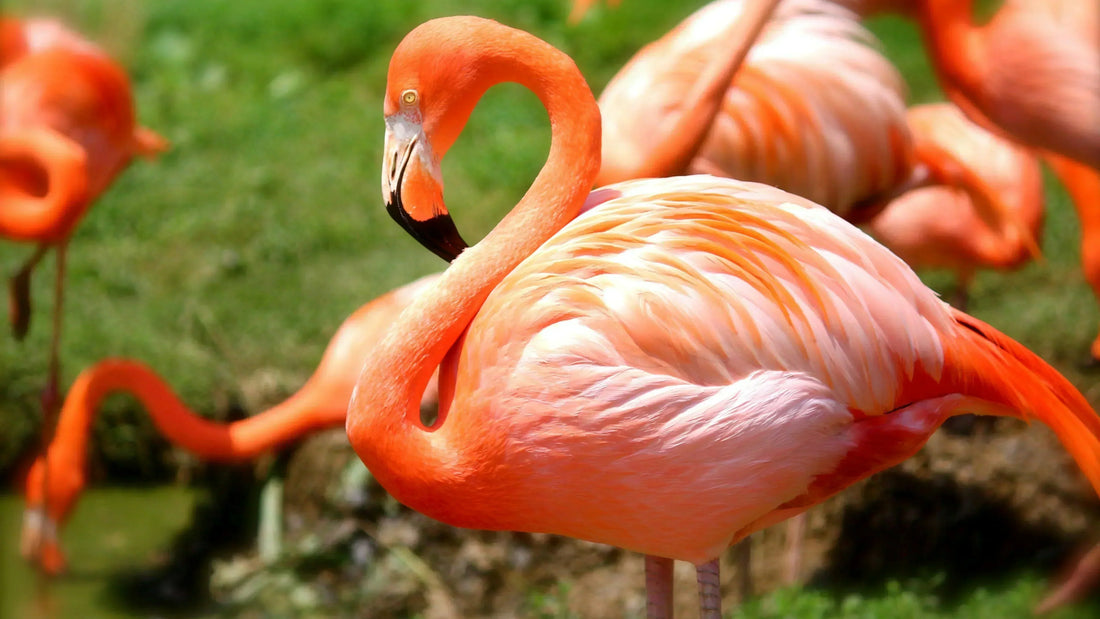After visiting a zoo or a tropical locale where flamingos tend to flock, kids will want to learn everything they can about these fanciful birds. Aside from their distinctive coloration and unusually long necks, there are so many more interesting things to explore about their behavior, habitat, diet, and anatomy. Here is a list of the most interesting facts about flamingos.

Flamingo Trivia Children Find Fascinating
Children will love learning more about one of the most recognizable birds spotted at zoos and in tropical climates around the world. Young kids are naturally curious, and fun flamingo facts are an awesome way to spark their interest in the world. When it comes to flamingos, these facts are super engaging because they often challenge what kids already know. Most children understand that birds fly, have feathers, and lay eggs. But imagine their surprise when they learn about a bird that's born grey and only turns pink because of its diet. Or a bird that stands on one leg to save energy, even while sleeping. These unexpected details defy what they might expect from a bird, making them incredibly memorable. Many of these captivating facts also directly relate to the flamingo's striking appearance or actions. The vivid image of a bright pink bird standing on one leg, or an enormous flock of thousands, makes these facts even more impactful and exciting for young learners. Picture books about flamingos share fun stories with facts about their lives woven throughout the pages. Readers are given an inside peak at how their unusual necks are critical for feeding, why they are pink, and other fascinating tidbits.
Flamingo Facts Just for Kids
Kids absolutely love learning about flamingos, and it's easy to see why! These birds have a combination of unique looks and fascinating habits that really capture a child's imagination. One of the biggest draws is their vibrant pink color. Imagine how cool it is for a kid to learn that flamingos actually eat their color! They get those brilliant hues from pigments in the brine shrimp and algae they munch on, which is a truly unique concept. But it's not just the color. Their unusual features also grab attention: those super long, thin legs, their graceful, flexible necks, and that distinctively curved bill all make them stand out from other birds. Plus, the fact that they can stand on one leg for ages, even when they're snoozing, is a curious and memorable trick that kids find amazing. Continue reading to uncover the most interesting facts about flamingos.

(1) Flamingos live 20 to 30 years.
When living in the wild, these famously pink birds survive for about two to three decades. There are a variety of threats to the birds that curtail their life expectancy including predators, loss of habitat, disease, and trauma. When they enjoy a life of leisure in a safe, captivated space, flamingos can enjoy about 50 to 60 years before passing away from natural causes.
(2) The oldest flamingo was 83 years old.
Visitors at the Adelaide Zoo in Australia were lucky enough to witness the oldest living flamingo ever documented. Aptly named Greater, due to it being part of the greater flamingo Phoenicopterus roseus species, the bird is famous for its remarkable longevity. Finally, in 2014, the bird was put to rest due to health conditions that were no longer manageable.
(3) They fall prey to larger birds and predatory land animals.
Eagles, storks and vultures are the primary threat to eggs and chicks, often feeding on them when the mothers have temporarily moved away from protecting their babies. Fully developed flamingos living in the wild are susceptible to hungry feral pigs, bobcats, coyotes, minks, raccoons, and foxes.

Habitat of Flamingos
(4) Florida has the most flamingos in the United States
Reportedly about 95% of pink flamingos in the United States reside along the Florida coastline. They are most frequently observed in the Florida Keys, Biscayne Bay, and in the Everglades. Once considered a non-native bird to the state, residents found them to be a invasive species and hunters would actively shoot them for their feathers. Recent efforts are in play to declare them native to the state in an effort to protect the birds and preserve the natural habitat so they can continue to thrive.
(5) Different species live all over the world.
These warm-blooded birds are native to temperate regions in countries around the globe. Size, species, and coloration varies depending on the locale, but their distinctive physique makes them highly identifiable. Regions with the most prolific flamingo populations include South America, Asia, Europe, North America, and the Middle East.
(6) They live near lakes and lagoons.
The birds congregate around large saline or alkaline lakes, which are landlocked water bodies with a higher concentration of salts and minerals than what is typical. Their beaks are specially designed to help them feed on food growing in salty water not easily accessible by other animals.

Flamingo Anatomy
(7) A flamingo is pink due to the food it eats.
At birth, their feathers are white or grey. However, when they reach about a month, they turn a beautiful shade of pink, sometimes with orange hues. This is due to the fact that foods they consume have a high concentration of carotenoids, with natural orange and red pigmentation. Different coloration is apparent based on the region where the flamingo lives. Interestingly, if a flamingo discontinues eating food with carotenoids, the pink feathers will molt away and be replaced by white feathers.
(8) Why the S-shaped neck is advantageous.
With 19 cervical (or neck) vertebrae, flamingos have an incredible ability to twist and turn their head when fishing for food, taking flight, or settling in for a nap. While most mammals, including giraffes, have only 7 vertebrae, flamingos clearly have a unique neck that is an effective tool for cleaning their feathers and even utilized during elaborate courtship rituals.
What Flamingos Eat
(9) They are filter feeders.
Rather than hunt food using vision, flamingos use their beaks to stir up the mud at the bottom of a shallow lake. They then scoop up the debris, including muddy water filled with potential food, turn their bills upside down, and use their tongues to push out the fluid. What remains is a nutrient-rich food source.
(10) Flamingos eat plants and animals.
hey love to snack on algae, especially blue-green and red varieties, as well as small seeds. While they do not eat fish of any sort, the long-necked birds eat both mollusks and crustaceans, most notably crabs, shrimp, lobster, krill, and crayfish.

Explore More Facts About Animals






